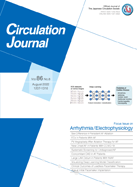Volume 86, Issue 8
Displaying 1-21 of 21 articles from this issue
- |<
- <
- 1
- >
- >|
Focus on issue: Arrhythmia / Electrophysiology
Original Articles
Catheter Ablation
-
Article type: ORIGINAL ARTICLE
Subject area: Catheter Ablation
2022Volume 86Issue 8 Pages 1207-1216
Published: July 25, 2022
Released on J-STAGE: July 25, 2022
Advance online publication: December 15, 2021Download PDF (2360K) Full view HTML -
Article type: EDITORIAL
2022Volume 86Issue 8 Pages 1217-1218
Published: July 25, 2022
Released on J-STAGE: July 25, 2022
Advance online publication: February 01, 2022Download PDF (323K) Full view HTML -
Article type: ORIGINAL ARTICLE
Subject area: Catheter Ablation
2022Volume 86Issue 8 Pages 1219-1228
Published: July 25, 2022
Released on J-STAGE: July 25, 2022
Advance online publication: July 01, 2022Download PDF (2730K) Full view HTML -
Article type: ORIGINAL ARTICLE
Subject area: Catheter Ablation
2022Volume 86Issue 8 Pages 1229-1236
Published: July 25, 2022
Released on J-STAGE: July 25, 2022
Advance online publication: July 01, 2022Download PDF (1450K) Full view HTML
Atrial Fibrillation
-
Article type: ORIGINAL ARTICLE
Subject area: Atrial Fibrillation
2022Volume 86Issue 8 Pages 1237-1244
Published: July 25, 2022
Released on J-STAGE: July 25, 2022
Advance online publication: January 26, 2022Download PDF (739K) Full view HTML -
Article type: ORIGINAL ARTICLE
Subject area: Atrial Fibrillation
2022Volume 86Issue 8 Pages 1245-1251
Published: July 25, 2022
Released on J-STAGE: July 25, 2022
Advance online publication: February 05, 2022Download PDF (934K) Full view HTML -
Article type: ORIGINAL ARTICLE
Subject area: Atrial Fibrillation
2022Volume 86Issue 8 Pages 1252-1262
Published: July 25, 2022
Released on J-STAGE: July 25, 2022
Advance online publication: July 01, 2022Download PDF (2972K) Full view HTML -
Article type: ORIGINAL ARTICLE
Subject area: Atrial Fibrillation
2022Volume 86Issue 8 Pages 1263-1272
Published: July 25, 2022
Released on J-STAGE: July 25, 2022
Advance online publication: July 01, 2022Download PDF (2254K) Full view HTML
Ventricular Arrhythmias
-
Article type: ORIGINAL ARTICLE
Subject area: Ventricular Arrhythmias
2022Volume 86Issue 8 Pages 1273-1280
Published: July 25, 2022
Released on J-STAGE: July 25, 2022
Advance online publication: April 07, 2022Download PDF (1583K) Full view HTML -
Article type: EDITORIAL
2022Volume 86Issue 8 Pages 1281-1282
Published: July 25, 2022
Released on J-STAGE: July 25, 2022
Advance online publication: May 18, 2022Download PDF (597K) Full view HTML
Devices
-
Article type: ORIGINAL ARTICLE
Subject area: Devices
2022Volume 86Issue 8 Pages 1283-1291
Published: July 25, 2022
Released on J-STAGE: July 25, 2022
Advance online publication: January 29, 2022Download PDF (1285K) Full view HTML -
Article type: ORIGINAL ARTICLE
Subject area: Devices
2022Volume 86Issue 8 Pages 1292-1297
Published: July 25, 2022
Released on J-STAGE: July 25, 2022
Advance online publication: March 31, 2022Download PDF (1236K) Full view HTML
Population Science
-
Article type: ORIGINAL ARTICLE
Subject area: Population Science
2022Volume 86Issue 8 Pages 1298-1306
Published: July 25, 2022
Released on J-STAGE: July 25, 2022
Advance online publication: February 19, 2022Download PDF (735K) Full view HTML
Images in Cardiovascular Medicine
-
Article type: IMAGES IN CARDIOVASCULAR MEDICINE
2022Volume 86Issue 8 Pages 1307-
Published: July 25, 2022
Released on J-STAGE: July 25, 2022
Advance online publication: February 16, 2022Download PDF (490K) Full view HTML -
Article type: IMAGES IN CARDIOVASCULAR MEDICINE
2022Volume 86Issue 8 Pages 1308-
Published: July 25, 2022
Released on J-STAGE: July 25, 2022
Advance online publication: March 01, 2022Download PDF (690K) Full view HTML -
Article type: IMAGES IN CARDIOVASCULAR MEDICINE
2022Volume 86Issue 8 Pages 1309-
Published: July 25, 2022
Released on J-STAGE: July 25, 2022
Advance online publication: March 16, 2022Download PDF (549K) Full view HTML -
Article type: IMAGES IN CARDIOVASCULAR MEDICINE
2022Volume 86Issue 8 Pages 1310-
Published: July 25, 2022
Released on J-STAGE: July 25, 2022
Advance online publication: March 17, 2022Download PDF (645K) Full view HTML -
Article type: IMAGES IN CARDIOVASCULAR MEDICINE
2022Volume 86Issue 8 Pages 1311-
Published: July 25, 2022
Released on J-STAGE: July 25, 2022
Advance online publication: March 19, 2022Download PDF (752K) Full view HTML
2022 JCS Report
-
Article type: 2022 JCS REPORT
2022Volume 86Issue 8 Pages 1312-1318
Published: July 25, 2022
Released on J-STAGE: July 25, 2022
Advance online publication: June 29, 2022Download PDF (1972K) Full view HTML
-
2022Volume 86Issue 8 Pages Cover8-
Published: July 25, 2022
Released on J-STAGE: July 25, 2022
Download PDF (300K) -
2022Volume 86Issue 8 Pages Content8-
Published: July 25, 2022
Released on J-STAGE: July 25, 2022
Download PDF (742K)
- |<
- <
- 1
- >
- >|
